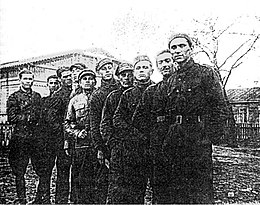Nalibaki massacre
| Naliboki massacre | |
|---|---|

Naliboki self-defence leaders possibly in a meeting with the Soviet officer (far left) prior to being massacred
|
|
| Location | Naliboki German-occupied Poland |
| Date | May 8, 1943 |
| Weapons | Shootings by automatic and semi-automatic weapons |
| Deaths | Approx. 129 Polish nationals |
| Perpetrators | Soviet partisans |
The Naliboki massacre (Polish: zbrodnia w Nalibokach) was the mass killing of approximately 128 Poles including boys by Soviet partisans on May 8, 1943 in the village of Naliboki in German-occupied Poland (now Belarus). Before the Nazi-Soviet invasion of Poland in 1939, Naliboki belonged to Stołpce county of the Nowogródek Voivodeship in eastern part of the Second Polish Republic.
Following Operation Barbarossa, the invasion of the Soviet Union by Nazi Germany, the Soviet resistance forces operated in the Naliboki Forest behind the German front lines of eastern Poland. Their NKVD leaders were sent in by Moscow headquarters in 1942 with full access to military hardware. The local members came from among the former Red Army soldiers of all ethnicities ("okrążeńcy"; Russian: окруженцы), and pro-Soviet Belarusians as well as Ukrainians. All daily provisions were acquired by the use of force, from settlements whose inhabitants were treated as enemies. The killings of peasants in order to inflict terror during acquisitions began in 1943 (in Kamień, Derewno, Borowikowszczyzna, Dziagwie, Rodziewszczyzna, etc). Naliboki was one of the settlements usually raided by them. Resulting from this, in August 1942 a self-defence unit was formed in the village.
In March 1943, Soviet partisans arranged for a meeting with the Polish self-defence leaders and lied about their true intentions. An agreement was signed with the Poles represented by Eugeniusz Klimowicz, against the so-called common robbers hiding in the forest. The NKVD did not intend to respect an agreement amounting to little more than a smokescreen and a surveillance technique.
...
Wikipedia
